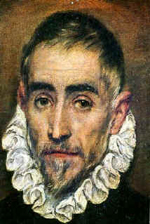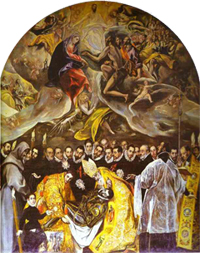El Greco
(Domenikos Theotokopoulos / 1541 – 1614)
(updated August 4, 2007)
El Greco, real name Domenikos Theotokopoulos, is without doubt the greatest painter who ever came from Crete. Actually, little is known about El Greco from the period when he lived in Crete. We know more of his Spanish period. Therefore, he is called a Spanish painter. El Greco was very well educated. He had a lot of interest for classical and contemporary literature.
 Self-portrait of El Greco
Self-portrait of El Greco
There is doubt about the birthplace of El Greco. It is claimed that the painter was born in the village of Fodele on Crete. In the town square of this village a bust for the painter has been placed and the residents are all very proud of the fact that El Greco was born in their village. Scientists doubt it, however. They say that El Greco was born in the city of Candia, the current Heraklion. In that period Crete still belonged to the Venetian republic.
One may assume that El Greco followed his painting lessons in Candia. At that time, Byzantine art and architecture was very popular in Crete. In the later period of El Greco these influences always came back in his works.
In about 1566 El Greco leaves to Venice. He started working in a studio of the painter Titian and is influenced by Tintoretto. They both paint is the style of the Renaissance. Between 1570 and 1576 resides El Greco in Rome, where he was inspired by the great artist Michelangelo. In Rome he comes into contact with people linked to the Church of the Spanish town Toledo. They get him to come over to Spain. He does this in 1577 right after he spent another year on the island of Malta has. El Greco settles down in Toledo. He soon gets commissions. His style changed. There is less Italian influence. He used different colors and the way of painting changed.
 The Burial of Count Orgaz
The Burial of Count Orgaz
In 1586 El Greco produced his greatest masterpiece, The Burial of Count Orgaz. On this painting is a nobleman who lies in his grave is portrayed, while his soul travels to a sky full of angels. Another well-known painting by the hand of El Greco is the painting View of Toledo, where a panorama of Toledo is depicted.
El Greco died on April 7, 1614 in Toledo. He was buried in a church called Santo Domingo el Antiquo. El Greco is widely respected for his work and the fact that he was a brilliant personality. After his death he was forgotten, however, until after about 300 years, his works were rediscovered.
The work of El Greco is on display in many famous museums around the world, such as the Louvre (Paris), the Hermitage (St. Petersburg), the National Gallery of Art (Washington) and the Museum del Prado (Madrid). The Rijksmuseum in Amsterdam has the work Christ on the cross in her possession. This work is currently not exhibited.
You can visit the town Fodele, in which is claimed that El Greco was born in. There is a square on which you can find a bust of El Greco. This bust was placed there in 1964 and is made by a sculptor named Apartis. The locals are trying to get as much money out of El Greco as possible. The village lies in a green area and is beautiful. It lies approximately 28 kilometers from Heraklion close to the main direction to Rethymno. There are two villages with the name Fodele. One, Fodele Beach, is located close to the main road and the other, the old Fodele, is located about 3 kilometers inland. 1 kilometer to the west of old Fodele lies a place called Arhontiko. Here you can find the house in which is believed El Greco was born in. To get to Fodele you can get a taxi from Heraklion. Of course, you can easily get there with a rental car.
If the degree of imitation of paintings from an artist indicates the quality of his works, El Greco would score very high. In addition to the works of the Italian primitives, the great French painters, Frans Hals and Vermeer the works of El Greco are among the most imitated worldwide.

|

